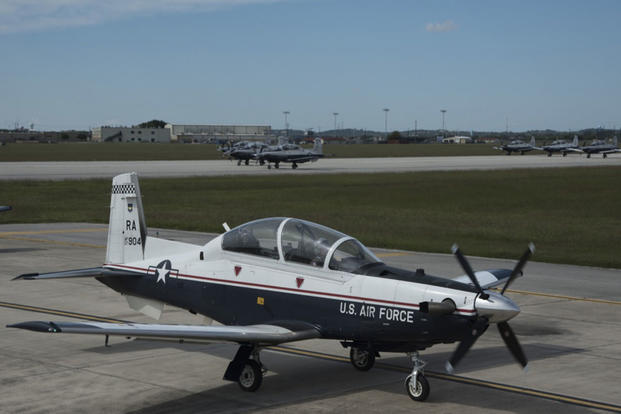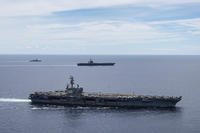A new helmet-based sensor that can read human biometrics alongside an aircraft's cockpit pressure levels just hit the market with Air Force pilots in mind.
Spotlight Labs, a veteran-owned small business founded by fighter pilots, on Wednesday announced that its SPYDR hypoxia sensor is ready to be used in aircraft that have had a history of pilots reporting hypoxia-like symptoms, such as the T-6 Texan II trainer.
In April, the Air Force Life Cycle Management Center's Agile Combat Support Directorate awarded a $195,000 contract to the company to test the SPYDR device, which was designed to "immediately alert T-6 aircrew of low oxygen in the bloodstream" and, as a result, "allow them to take actions to prevent physiological symptoms in flight," the Air Force said at the time.
SPYDR can detect and warn pilots of impending hypoxia symptoms from both the human and aircraft perspective. The device also records the flight data for pilots and officials to analyze and improve in-flight methods.
Related content:
- Cobham Gets Pentagon Contract to Develop Pilot Life Support System
- Google Artificial Intelligence Specialists May Help Military Pilots Breathe Better
- Lawmakers Rip Brass for Handling of Hypoxia Incidents
"After the grounding of the T-6 training fleet by the United States Air Force, Spotlight Labs executed destructive testing, electromagnetic interference testing and acoustic testing on the SPYDR," the company said in a release.
"Spotlight Labs executed physical demonstrations in an altitude chamber, a centrifuge and a ground-based restricted oxygen breathing device," the release said.
Spotlight, of Sterling Heights, Michigan, used SPYDR on more than 100 training flights in T-6 aircraft at various Air Force training bases to prove its effectiveness.
How it works: The gadget replaces existing ear cups in a flight helmet. It does not require any manipulation within the cockpit for the device to work, Spotlight Labs said.
It also includes "three sensors and a bone-conducting transducer that collects data at relevant physiological points on the neck and head," according to the description.
The sensor can then read breath, heart rate and other biometrics. And it records data multiple times per second in real time, alerting pilots of any abnormalities with different sound alarms.
"Everything in tactical aviation is instrumented -- except the pilot," Brian Bradke, the lead biomedical engineer at Spotlight Labs as well as an experienced F-16 Fighting Falcon instructor pilot, said in the release.
Bradke served with the New Jersey Air National Guard's 177th Fighter Wing, according to the service.
"The SPYDR instruments the operator, giving individual pilots tools for safety and performance in flight, while collecting valuable data that will fuel improved performance and increased risk mitigation for the pilot community as a whole," he said.
Once the device's flight and human data are combined, it can be analyzed "using machine learning and artificial intelligence techniques that demonstrate increases or decreases in individual performance, workload and stress factors," the release said.
"This data can be incorporated to quantify spikes in risk for specific aircraft, units, mission types, geography or other flight elements," it added.
During the tests in April, Air Force officials said it was possible that "SPYDR could be issued to the entire T-6 fleet" if its evaluation showed positive outcomes.
The sensor was originally meant for commercial use, but a team of former fighter pilots and engineers at Spotlight Labs produced a military-grade device after a bout of hypoxia incidents manifested throughout the military.
The Defense Department has been unable to find a cause for the hypoxia-like symptoms -- disorientation, shortness of breath, confusion and wheezing, among others.
Last year, Air Force Chief of Staff Gen. David Goldfein said the manifestations may not be hypoxia in some cases, but instead hypocapnia, or reduced carbon dioxide in the blood. Hypocapnia often presents symptoms similar to hypoxia, such as dizziness and disorientation.
The Air Force last February ordered an indefinite operational pause for all T-6 aircraft at Columbus Air Force Base, Mississippi; Vance Air Force Base, Oklahoma; and Sheppard Air Force Base, Texas, after a number of pilots at several bases experienced unexplained physiological events [UPEs] while in flight.
The service lifted the pause almost a month later after conducting flight tests, but still could not identify the cause of the episodes.
-- Oriana Pawlyk can be reached at oriana.pawlyk@military.com. Follow her on Twitter at @Oriana0214.










